|
|
 |
Fiche d'espèce de Copépode |
|
|
Cyclopoida ( Ordre ) |
|
|
|
Thaumatopsyllidae ( Famille ) |
|
|
|
Thaumatopsyllus ( Genre ) |
|
|
| |
Thaumatopsyllus paradoxus Sars, 1913 (F,M) | |
| | | | | | | Syn.: | Thespesiopsyllus paradoxus : Sewell, 1949 (p.128); Fosshagen, 1970 a (p.33, Rem.F,M, figs.M); Isaac, 1975 (n°144/145, p.2, figs.F,M); Huys & Boxshall, 1991 (p.154, 233, 442, 467, figs.F,M) | | | | Ref.: | | | Sars, 1913 a (p.5, Descr.F, figs.F); 1921 a (p.5, Descr.F, figs.F); Rose, 1933 a (p.338, figs.F); Ho, Dojiri, Hendler & Deets, 2003 (p.589, tab.1); Boxshall & Halsey, 2004 (p.691, p.690: figs.F,M) | 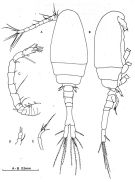 issued from : A. Fosshagen in Sarsia, 1970, 42. [p.37, Fig.1]. As .
Male (from Raunefjorden, W Norway): A, habitus (dorsal); B, idem (lateral right side); C, A1; D, P4; E, P5.
Nota: Both A1 geniculate, proximal part of several indistinct, short segments (8 or 9 altogether); a groove is present on the 7th segment from the end. Devoided of mouth parts. Main articulation between the prosome and urosome between 4th and 5th pedigers segments. Urosome 5-segmented (including the 5th pediger segment). Genital segment with ventro-laterally two genital protuberances each distally 2 short, stout spines.
|
 issued from : J.-s. Ho, M. Dojiri, G. Hendler & G.B. Deets in J. Crust. Biol., 2003, 23 (3). [p.589, Table 1]. Characters of female. Armature formulae for legs are presented as outer margin first, with Roman numerals for the number of spines, and Arabic numerals for setae. Data and armature formulae of the legs based on information from Sars (1921).
|
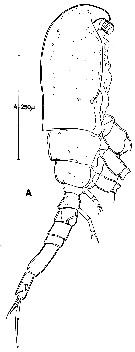 issued from : R. Huys & G.A. Boxshall in Copepod Evolution, 1991, 159. [p.233, Fig. 2.8.34, A]. As Thespesiopsyllus paradoxus. Male (from Norway: Raunefjordden): A, habitus (lateral)
|
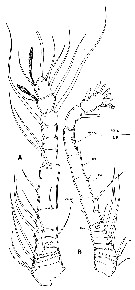 issued from : R. Huys & G.A. Boxshall in Copepod Evolution, 1991, 159. [p.234, Fig. 2.8.35, A-B]. As Thespesiopsyllus paradoxus. Female : A, A1. Male: B, A1.
|
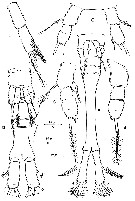 issued from : R. Huys & G.A. Boxshall in Copepod Evolution, 1991, 159. [p.235 ,Fig. 2.8.36, A-F]. As Thespesiopsyllus paradoxus. Female: A, urosome (ventral); B, P5; C, P4. Male: D, urosome (ventral); E, P4; F, P5.
|
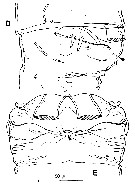 issued from : R. Huys & G.A. Boxshall in Copepod Evolution, 1991, 159. [p.234, Fig. 2.8.35, A]. As Thespesiopsyllus paradoxus. Female: D-E, genital complex (lateral and ventral, respectively); copulatory pore arrowed.
|
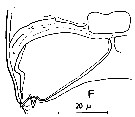 issued from : R. Huys & G.A. Boxshall in Copepod Evolution, 1991, 159. [p.234, Fig. 2.8.35, F]. As Thespesiopsyllus paradoxus. Male: P6.
|
.png) issued from : G.O. Sars in An Account of the Crustacea of Norway, with short descriptions and figures of all the species, 1921a, 8. [Pl. I]. Female (from Norway): C, cephalon (ventral and lateral, respectively); F, caudal rami; Ur, anterior portion of urosome; P1, P3, P4, P5, legs 1, 3, 4, 5. Nota: A1 9-segmented with scattered simple setae, 3rd segment much the largest, the 6 outmost segments short and equal-sized. Body transparent and nearly colourness, its anterior part being filled up with a number of clear oil-bubbles of unequal size and partly of a light orange colour. Eye replaced by a large transverse patch of a light red pigment, in which, however, no trace of refracting elements could be detected. The last two pairs of legts very unlike the former, and reduced to simple small 3-segmented stems, with the middle segment very small, last rounded in shape and provided with 2 unequal apical spines. Caudal rami slightly diverging and oblong quadrangular in form, 4 times as long as broad and a little widening distally; seta of outer edge occuring about in the middle; apical setae of moderate size and densely ciliated, the outermost one shorter than the other three.
|
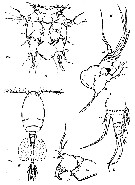 issued from : J. Bresciani & J. Lützen in Vidensk. Meddrdansk naturh. Foren, 1962, 124. [p.388, Text-fif.5]. as Thespesiopsyllus paradoxus. Metanauplius (from Norway): A, habitus (ventral); B, A2; C, ? Mxp; D, Md. Female (after Sars, 1921): E, habitus (dorsal). a1 = A1; a2 = A2; at = arthrite; ex = exopod; en = endopod; gn = gnathit; md = Md; mp = Mxp (?); sp = sympodium. Nota: Nauplii collected in the stomach folds of Ophiurides. The last nauplius stage certainty moults in the stomach cavity of the Ophiuride ( Ophiothrix fragilis and O. aculeata) and thereafter leaves its host through its mouth opening as the 1st copepodite stage. The mouthless copepodites are nodoubt exclusively planktonic; unfortunately, the authors did not obtained the mature stage. All naulius had 4 pairs of appendages and therefore are strictly speaking metanauplius
| | | | | NZ: | 1 | | |
|
Carte de distribution de Thaumatopsyllus paradoxus par zones géographiques
|
| | | | Loc: | | | Norway (Oslo Fjord: Drøbak; Trondhjem Fjord: Selven), Sweden, Skagerak | | | | N: | 3 | | | | Lg.: | | | (663) F: 1,65; (664) F: 1,64-1,51; M: 1,08-0,76; {F: 1,51-1,65; M: 0,76-1,08} | | | | Rem.: | Close to the bottom (depths between 30 and 245 m) in Raunefjorden (Norway).
Fosshagen (1970, p.35) points out concerning the female: the A1 seems to have more segments than the 9 mentioned by Sars, since the proximal part consists of a number of partially fused ones; 8 or 9 segments can be discerned proximally, thus bringing the total number of segments up to 14 or 15. | | | Dernière mise à jour : 28/11/2023 | |
|
|
 Toute utilisation de ce site pour une publication sera mentionnée avec la référence suivante : Toute utilisation de ce site pour une publication sera mentionnée avec la référence suivante :
Razouls C., Desreumaux N., Kouwenberg J. et de Bovée F., 2005-2026. - Biodiversité des Copépodes planctoniques marins (morphologie, répartition géographique et données biologiques). Sorbonne Université, CNRS. Disponible sur http://copepodes.obs-banyuls.fr [Accédé le 19 janvier 2026] © copyright 2005-2026 Sorbonne Université, CNRS
|
|
 |
 |









.png)


